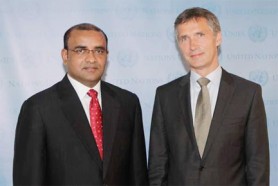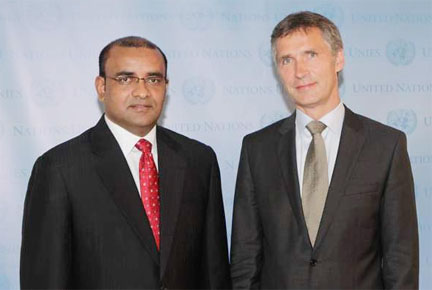The fund into which Norway is to funnel forest protection money is to be set up by the end of this month after which Oslo will deliver its first tranche of US$30M.

According to a GINA release, President Bharrat Jagdeo and Norway’s Prime Minister Jens Stoltenberg yesterday announced the establishment of the Guyana REDD+ Investment Fund (GRIF) and reiterated that they have invited the World Bank to act as the fund manager.
They are in New York to attend the second meeting of the United Nations Secretary General’s Advisory Group on Finance, which has been set up to identify ways to raise US$100 billion in annual climate finance for developing countries by 2020.
The release added that Norway will be the first contributor to the GRIF and that the payment was in recognition of Guyana’s efforts to protect its 16 million-hectare rainforest and follows the memorandum of understanding signed by the two countries in November last year.
Norway intends to pay up to US$250 million into the GRIF between 2010 and 2015, based on Guyana’s performance in avoiding greenhouse gas emissions from deforestation and forest degradation, as well as Guyana’s on-going and planned strengthening of inclusive and transparent forest management, the release continued. The first tranche had been expected by the Guyana Government much earlier this year.
Guyana is expected to invest the GRIF revenues to implement the Low Carbon Development Strategy (LCDS).
According to GINA, this will enable Guyana to place its forest under long-term protection, catalyse public and private investment for clean energy and create new low carbon economic and employment opportunities for forest dependent communities and other Guyanese citizens.
The process will be evolving with the full and effective participation of involved stakeholders, including indigenous peoples groups, it added.
“Prime Minister Stoltenberg has long demonstrated global leadership in the fight against climate change,” GINA reported Jagdeo as saying.
The president said that the work Guyana and Norway were doing together would “provide the world with a model of how national scale action to protect forests can help to create a path to a prosperous, low carbon future.”
“Guyana’s model is truly visionary. Not only is the country making tough decisions to protect its forest, but it is also planning to invest heavily to move its economy onto a long-term low carbon trajectory,” GINA quoted Stoltenberg as saying.
Jagdeo and Stoltenberg, GINA said, repeated their desire to continue a close political dialogue on the global response to climate change.
Minister of Finance Dr. Ashni Singh will set out further details regarding the GRIF in a statement to the National Assembly tomorrow.
In May, during an interview with Staboek News in Oslo, Jagdeo had spoken about difficulties in discussions with the World Bank over intermediation of the money for GRIF.
“We started the work with the World Bank and we think to a large extent they wanted to use old tools, old development tools in a very new situation and therefore both partners, Norway and Guyana, agreed that this couldn’t work”, the President said. He recounted that at one point the World Bank indicated that they may not be able to develop new instruments. “Fortun-ately that has moved on and we are very close to reaching agreement on a very different approach to the intermediation of these funds but we are having some difficulties because we are the first to be designing such a system and hopefully this system will be replicated and used by others”, he said.
Jagdeo declared that in the design of this mechanism, they have to be very conscious of the role that Guyana is playing as a developing, forested country. He said that the fund cannot just be designed to suit the needs of the donors or the multilateral institutions but has to ensure that the developing and forested countries interests’ are safeguarded as well. While there are concerns about safeguards, Guyana also has concerns about timely disbursement of funds and minimal bureaucracy once the money is used in an accountable manner without harming the environment or people, the President explained.
He said that he had spoken with World Bank President, Robert Zoellick on this and Norway’s Prime Minister Stoltenberg. “To be fair, I think the President of the World Bank understands this and understands that if they get it right too then the World Bank could be a preferred institution for intermediating large sums of money, not just the Guyana funds but large sums of money”, Jagdeo said. He added that unfortunately at levels below the presidency, there is a “lack of creativity” and “old thinking” and a cautious approach which will not work in this situation. He said that they wanted to use things that they are accustomed to, “old grant agreements in a very new situation that demands very new instruments.”

